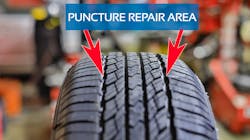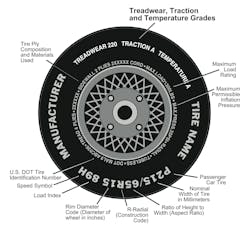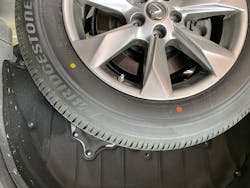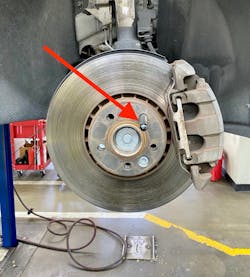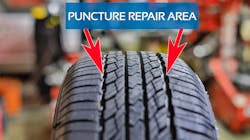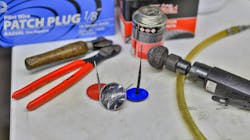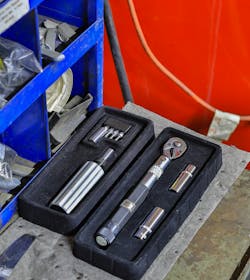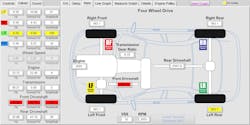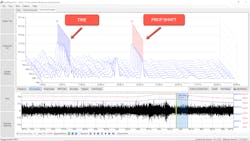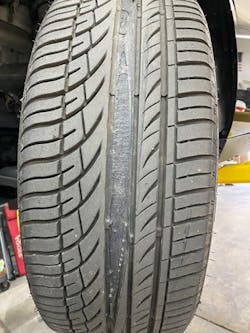How to service tire and wheel issues – tire grading, TPMS, NVH, and more
Wheel and tire service requirements on today’s vehicles are quite demanding. Technicians possessing the ability to address tire pressure and monitoring system (TPMS) issues and deal with noise, vibration, and harshness (NVH) are in demand. Consumers today are growing more and more accustomed to a smooth and quiet ride due to the advancements in vehicle design. Given all of the advanced technologies populating the automobile, technicians now must make sure they are adhering to all of the special precautions and service procedures. In fact, you may have run across vehicles that require additional services following a wheel alignment, such as a zero-point calibration or camera/radar aiming.
Today's tire design has evolved tremendously over the years. Tire manufacturers are working hard with OEMs to produce a tire with less rolling resistance and less NVH and continue to deliver a high level of safety.
Tire grading
The National Highway Transportation Safety Administration (NHTSA) has published a document outlining all of the uniform tire grading guidelines. (Figure 1) This document is available for download and should serve as a great reference when dealing with tires.Now, I'm sure you've seen a lot of tires that are installed on vehicles where these dots don't line up. I believe the main reason for this is because personnel servicing tires and wheels are not aware of this system. Why do you want to do this? When you follow this standard practice, you will ultimately have a far better chance at successfully balancing the entire wheel combination with the least amount of weight needed to achieve a zero-balance condition. Another good reason for following this practice is that you will be able to use this as a reference point if a customer returns after a tire repair complaining of a vibration issue. The first inspection should be to verify that none of the wheel weights had prematurely departed the wheel. Additionally, you can reference the dot alignment versus the valve stem or indicator. If you find that these have shifted, then the tire has rotated on the rim. This could be caused by a combination of things: too much lubricant used on the bead during assembly, the client recently experienced a rapid braking event, etc.
Tire rotation
Tire rotation is a service that should be performed on a regular schedule as per the vehicle manufacturer’s requirements. The reason for rotation is so that we can optimize tire wear evenly across all wheels. In most cases, tire rotation intervals typically run between 6,000 to 7,000 miles. On some vehicles, you'll find that they are not using the traditional wheel studs that are affixed to the hub assembly, but rather they use a screw-type lug nut. For these, you'll want to have a special stud tool (Figure 3) that will help with wheel assembly removal and installation. This will also help you prevent wheel contact with the brake rotor. This is especially important on vehicles equipped with carbon fiber brake rotors that can easily chip or break if a wheel were to encounter it.Tire repair
Puncture repairs can only be performed within the limits shown in Figure 4.Wheel alignment
A wheel alignment offers the technician the opportunity to fine-tune the operational characteristics as they relate to steering, handling, and braking performance. Additionally, vehicles equipped with advanced driver assistance systems (ADAS) may require additional services such as camera/radar aiming, steering angle resets, and more. Service information procedures should be consulted on late-model vehicles and especially for ADAS-equipped vehicles.
Tire pressure monitoring systems (TPMS)
When servicing wheels and tires with TPMS sensors, the proper service procedures usually include the replacement of the seals, gaskets, and valve cores. Be sure to reassemble using the proper torque levels which can be performed by using torque tools such as those shown in Figure 6.Noise vibration and harshness (NVH)
You may find yourself dealing with a vibration complaint on a vehicle occurring at certain speeds and road conditions. Oftentimes these can be difficult to address. There are a few NVH measurement tools out there in the marketplace that can be used to narrow down such vibrations. Automotive Test Solutions offers their Intelligent Vibration Analyzer to help with identifying vibration sources and provides an easy-to-understand visual data map of the vehicle. (Figure 7)The tool offers a graphical display of the vibration levels and what their sources are. The system uses a single three-axis accelerometer as opposed to the four-channel system from ATS.
Tire inspection
A thorough inspection of the tires during service should always include checking the complete tire including date codes, sizes, and tread condition. The tire in Figure 9 met up with some bad debris on the road and at first glance, it didn’t look too bad. A closer inspection revealed a sliced-out section of the tire.About the Author

Scott Brown
Founder - Diagnostic Network
Scott is an ASE Master Certified Automobile Technician with L1, L3, & L4 credentials and has over 39 years of professional service industry experience. As an independent shop owner in Southern California and with his engagement at various levels of within our industry, he continuously strives to move the industry forward through networking, education, communications, and training. Scott is a founder of the Diagnostic Network (https://diag.net/) which was born in 2018 after he retired after 22 years at iATN, where he served as company president.
Brown is also the host of Professional Tool and Equipment News (PTEN) and VehicleServicePros.com podcast, Torque Factor. The podcast addresses the latest automotive service technologies while focusing on expanding knowledge and awareness around tools, equipment, education, and industry trends.
